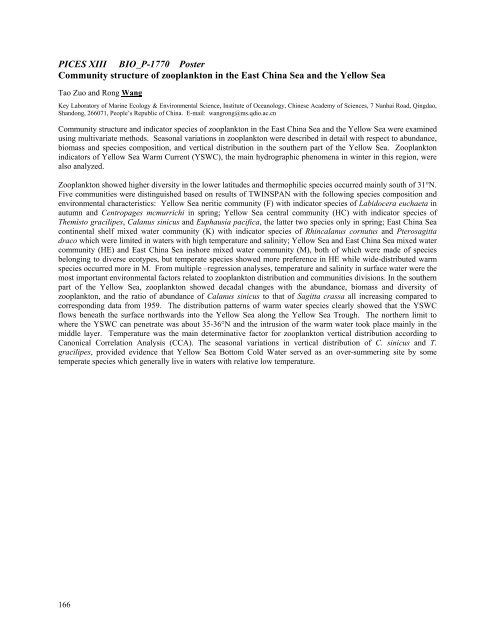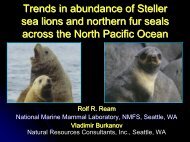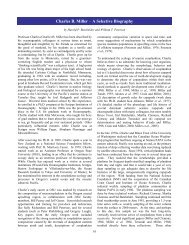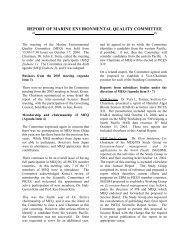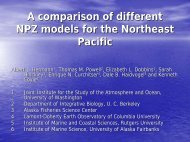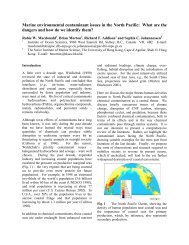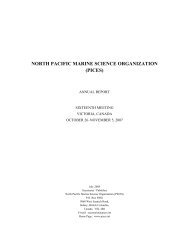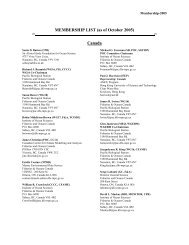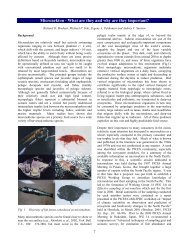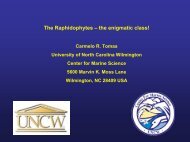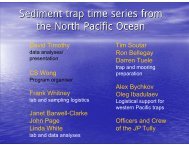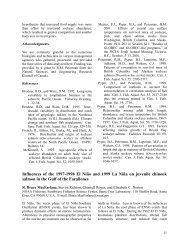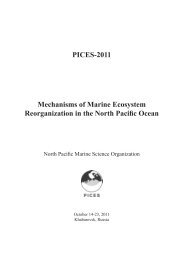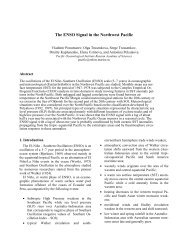- Page 3:
Keynote AddressPICES XIIISend out t
- Page 8 and 9:
14:50-15:10 Coffee break15:10-15:30
- Page 10 and 11:
PICES XIII S1-1827 PosterThe red fl
- Page 12 and 13:
PICES XIII S1-2018 InvitedRelation
- Page 14 and 15:
PICES XIII S1-2049 InvitedZooplankt
- Page 16 and 17:
forage base while physical gradient
- Page 19 and 20:
S2BIO Topic SessionMechanisms that
- Page 21:
09:20-09:40 Rubén Rodríguez-Sánc
- Page 24 and 25:
PICES XIII S2-1852 OralMechanisms o
- Page 26 and 27:
PICES XIII S2-2003 OralTop-down mod
- Page 28 and 29:
PICES XIII S2-2116 OralWhen, where
- Page 30 and 31:
espectively, several lines of evide
- Page 32 and 33:
PICES XIII S2-1939 InvitedWhy do om
- Page 34 and 35:
ased on optimal temperatures for la
- Page 37 and 38:
S3BIO Topic SessionRole of gelatino
- Page 39 and 40:
PICES XIII S3-1824 OralPredation on
- Page 41 and 42:
PICES XIII S3-1908 PosterSeasonal d
- Page 43 and 44:
stable-isotope ratios of carbon and
- Page 45 and 46:
PICES XIII S3-1930 OralA comparison
- Page 47 and 48:
S4FIS/BIO Topic SessionHot spots an
- Page 49:
17:00-17:20 Vincent F. Gallucci and
- Page 52 and 53:
PICES XIII S4-1983 OralExistence of
- Page 54 and 55:
the coast to 200 km offshore. More
- Page 56 and 57:
PICES XIII S4-1913 InvitedHow to di
- Page 58 and 59:
PICES XIII S4-2046 OralIdentifying
- Page 60 and 61:
PICES XIII S4-2097 InvitedAn oceano
- Page 62 and 63:
PICES XIII S4-1797 PosterZone of
- Page 65 and 66:
S5MEQ Topic SessionIntroductions of
- Page 67 and 68:
PICES XIII S5-1777 OralAnthropogeni
- Page 69 and 70:
PICES XIII S5-2178 OralThe Ballast
- Page 71 and 72:
Pseudo-nitzschia, causative organis
- Page 73:
PICES XIII S5-2139 OralIntroduced s
- Page 77 and 78:
PICES XIII S6-2203 OralMethods for
- Page 79 and 80:
PICES XIII S6-2104 PosterEcologic a
- Page 81 and 82:
S7POC/MONITOR Topic SessionApplicat
- Page 83:
PostersYury N. Volkov, Igor E. Koch
- Page 86 and 87:
PICES XIII S7-1801 OralEl Niño phe
- Page 88 and 89:
PICES XIII S7-2189 PosterMain effec
- Page 90 and 91:
PICES XIII S7-2090 PosterNorth Paci
- Page 92 and 93:
PICES XIII S7-1861 PosterSatellite
- Page 94 and 95:
almost constant over the whole year
- Page 96 and 97:
overestimation of chl-a in the Beri
- Page 98 and 99:
PICES XIII S7-2196 PosterInterannua
- Page 101 and 102:
S8POC Topic SessionThe impacts of c
- Page 103:
PostersAndrey G. Andreev and Viktor
- Page 106 and 107:
the Pacific Ocean. Analyses of the
- Page 108 and 109:
PICES XIII S8-1834 OralAttributing
- Page 110 and 111:
will report results of a workshop c
- Page 112 and 113:
PICES XIII S8-2047 InvitedMicrobial
- Page 114 and 115:
PICES XIII S8-2140 OralInterannual
- Page 116 and 117:
salinity showed similar distributio
- Page 119 and 120:
S9CCCC Topic SessionThe impacts of
- Page 121 and 122: 13:50-14:10 Randall M. Peterman, Br
- Page 123 and 124: PICES XIII S9-1900 OralComparison o
- Page 125 and 126: PICES XIII S9-1931 OralU.S. GLOBEC:
- Page 127 and 128: PICES XIII S9-1807 OralDid regime s
- Page 129 and 130: depth ranges are computed for summe
- Page 131 and 132: PICES XIII S9-2131 OralA new intern
- Page 133 and 134: PICES XIII S9-1894 OralThe latitudi
- Page 135 and 136: Southern Oscillation Index) were of
- Page 137 and 138: PICES XIII S9-1789 OralPopulation d
- Page 139 and 140: PICES XIII S9-2076 OralProgresses a
- Page 141 and 142: PICES XIII S9-2108 OralThe importan
- Page 143 and 144: PICES XIII S9-1968 OralInterannual
- Page 145: PICES XIII S9-1871 OralChanging oce
- Page 148 and 149: PostersIrina V. IshmukovaAssessing
- Page 150 and 151: PICES XIII S10-2041 OralQuantifying
- Page 152 and 153: PICES XIII S10-2083 PosterModeling
- Page 154 and 155: phytoplankton growth throughout the
- Page 157 and 158: PICES XIII S11-1806 E-posterResearc
- Page 159 and 160: PICES XIII S11-1975 E-posterDevelop
- Page 161: cyclonic eddy field and then moved
- Page 164 and 165: Eun Seob ChoPCR-based assays for de
- Page 166 and 167: PICES XIII BIO_P-1980 PosterPCR-bas
- Page 168 and 169: marine organisms. Acoustic methods
- Page 170 and 171: the total copepod biomass through t
- Page 174 and 175: 16:05-16:20 Andre Buchheister and M
- Page 177 and 178: PICES XIII FIS_P-1814 PosterModelin
- Page 179 and 180: around the islands. In 1993, there
- Page 181 and 182: coefficient. The model comparison u
- Page 183 and 184: central region of the Bungo Channel
- Page 185 and 186: PICES XIII FIS_P-1950 PosterDensity
- Page 187 and 188: PICES XIII FIS_P-1995 OralInterannu
- Page 189 and 190: variability in age class structure
- Page 191 and 192: PICES XIII FIS_P-1957 OralGeographi
- Page 193 and 194: PICES XIII FIS_P-1831 PosterGrowth
- Page 195 and 196: General Poster SessionWednesday, Oc
- Page 197: Nina I. Savelieva, Vladimir I. Pono
- Page 200 and 201: PICES XIII GP-1962 PosterNew compre
- Page 202 and 203: PICES XIII GP-2019 PosterMultiyear
- Page 204 and 205: PICES XIII GP-1839 PosterDeath of t
- Page 206 and 207: PICES XIII GP-1799 PosterStock enha
- Page 208 and 209: PICES XIII GP-1891 PosterSeamounts
- Page 210 and 211: PICES XIII GP-1905 PosterBiomarkers
- Page 212 and 213: etween 170˚E and 166˚W. In most c
- Page 214 and 215: ottom layers because of denitrifica
- Page 216 and 217: has increased. But in the Norwegian
- Page 218 and 219: PICES XIII GP-1841 PosterHorizontal
- Page 221: W1MIE-AP Workshop and Advisory Pane
- Page 224 and 225:
11:45-12:10 Hyun-Cheol Kim, Sinjae
- Page 226 and 227:
PICES XIII W2-1932 PosterGrowth rat
- Page 228 and 229:
Copepods were abundant in April and
- Page 230 and 231:
PICES XIII W2-2082 OralSeasonal cyc
- Page 233 and 234:
W3CCCC WorkshopLinking open ocean a
- Page 235 and 236:
PICES XIII W3-2004 InvitedModeling
- Page 237 and 238:
characteristic cyclic relationship.
- Page 239 and 240:
W4PICES/CLIVAR WorkshopScale intera
- Page 241:
13:30-14:15 Richard A. Feely, C. L.
- Page 244 and 245:
PICES XIII W4-1984 InvitedCLIVAR/CO
- Page 246 and 247:
PICES XIII W4-1992 InvitedThe impac
- Page 248 and 249:
PICES XIII W4-2155 InvitedGlobal li
- Page 250 and 251:
the subtropic Northwest Pacific and
- Page 252 and 253:
Environmental changes at inter-annu
- Page 254 and 255:
14:30-15:00 Discussion of usefulnes
- Page 257 and 258:
W5 Workshop AbstractsPICES XIII W5-
- Page 259 and 260:
PICES XIII W5-2193 OralUse of Korea
- Page 261 and 262:
HAB Meeting AbstractsPICES XIII HAB
- Page 263 and 264:
PICES XIII HAB-2039 OralThe use of
- Page 265:
W6MBM-AP WorkshopCombining data set
- Page 268 and 269:
PICES XIII W6-1973 OralDistribution
- Page 271 and 272:
Index of AuthorsPresenter Name: Pap
- Page 273 and 274:
DDagg, Michael S3-1979 p.33Daly, El
- Page 275 and 276:
IIanson, Debby S8-2147 p.104Ichihar
- Page 277 and 278:
Kruse, Gordon H. FIS_P-1873 p.182S2
- Page 279 and 280:
Nagasawa, Toru FIS_P-1922 p.175Naka
- Page 281 and 282:
Samko, Eugene V. S4-1815 p.53Samuel
- Page 283 and 284:
Vinnikov, Andrey V. FIS_P-2088 p.18
- Page 285:
PICES AcronymsAP Advisory PanelAPN


